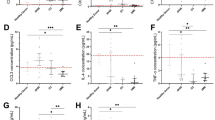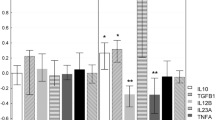Abstract
Background
Cardiac syndrome X is typically characterized by effort induced anginal pain with ST segment depression suggestive of myocardial ischemia and normal coronary arteries at angiography. The possible mechanism that may participate in the pathology of CSX is a microvascular dysfunction related to inflammatory process affecting endothelium.
Interferon γ (IFN-γ) is an important cytokine in inflammatory reaction. It acts through its specific receptor composed of 2 subunits
IFN-γ R1 (ligand binding) and R2 (signal transduction). The expression and proportion of these subunits influences IFN-γ activity. The aim of the study was to assess the gene expression of IFN-γ and its receptors in peripheral blood mononuclear cells (PBMC) from patients with syndrome X.
Methods
The study was carried out in 36 patients aged 44–77 (average 57 years old) with cardiac syndrome X and 23 sex- and age-matched healthy subjects (control group). To evaluate gene expression of IFNγ and its receptor total mRNA was extracted from peripheral blood mononuclear cells (PBMC) and the number of mRNA copies were assessed by quantitive reverse transcriptase polymerase chain reaction (QRT-PCR).
Results
We have not observed statistically significant differences in INFγ gene expression between studied group and control. Genes encoding IFNγ receptor subunits showed higher expression in PBMCs from patients with cardiac syndrome X vs control subjects (IFNγR1, 97,244 ± 26,956 c/μg vs 12,120 ± 2,940 c/μg, p < 0.005, respectively and IFNγR2, 129,153 ± 36,883 c/μg vs 16,445 ± 2,923 c/μg, p < 0.005, respectively).
Conclusion
Variation in transcriptional activity of genes encoding INF-γ receptor subunits may affect function of microvasculature and thereby participate in the pathology of cardiac syndrome X.

Similar content being viewed by others
References
Kemp, H. G. 1973. Left ventricular function in patients with the anginal syndrome and normal coronary angiograms. Am. J. Cardiol. 32:375–376.
Panting, J. R., P. D. Gatehause, G. Z. Yang, and F. Grothues. 2002. Abnormal subendocardial perfusion in cardiac syndrome X detected by cardiovascular magnetic resonance imaging. N. Engl. J. Med. 346:1948–1953.
Tymińska-Sędek K., and M. Jakubowska-Najnigier. 2002., Chory z kardiologicznym zespołem X. Terapia. 9(2):41–47.
Rogacka D., and H. Wysocki. 2003. Dławica mikronaczyniowa i zaburzenia percepcji bólu jako główne składowe patogenetyczne kardiologicznego zespołu X. Folia Cardiol. 10:553–561.
Kaski J. C., G. M. Rosano, and P. Collins. 1995. Cardiac syndrome X: Clinical characteristics and left ventricular function long-term follow-up study. JACC 25:807–814.
Johnson B. D. et al. 2004. Prognosis in women with myocardial ischemia in the absence of obstructive coronary disease: results from the National Institutes of Health–National Heart, Lung, and Blood Institutes-sponsored Women’s Ischemia Syndrome Evaluation (WISE). Circulation 109:2993–2999.
Kołodziej K., and J. D. Kasprzak. 2001. Kardiologiczny zespół X. Forum Kardiol. 4:1425–3674.
Vazquez-Rey E., and J. C. Kaski. 2003. Cardiovascular syndrome X and endothelial dysfunction. Rev. Esp. Cardiol. 56:181–192.
Leu H. B., C. P. Lin, W. T. Lin, T. C. Wu, S. J. Lin, and J. W, Chen. 2006. Circulating mononuclear superoxide production and inflammatory markers for long-term prognosis in patients with cardiac syndrome X. Free Radic. Biol. Med. 40:983–991.
Zhang P., Z. Chen, F. Chen, M. Li, J. Fan, H. Zhou, J. Liu, and Z. Huang. 2004. Expression of IFN-γ and its receptor alpha in the peripheral blood of patients with chronic hepatitis C. Chin. Med. J. 117(1):79–82.
Deb, D. K., A. Sassano, F. Lekmine, B. Majchrzak, A. Verma, S. Kambhampat, S. Uddin, A. Rahman, E. N. Fis, and L. C. Platanias. 2003. Activation of Protein Kinase CD by IFN. J. Immunol. 171:267–273.
Allione A., P. Bernabei, M. Bosticardo, S. Ariotti, S. Forni, and F. Novell. 1999. Nitric oxide suppresses human T lymphocyte proliferation through IFN-γ-dependent and IFN-γ-independent induction of apoptosis. J. Immunol. 163:4182–4191.
Pestka, S. 1997. The interferon receptors. Semin. Oncol. 24:S9–18–S9–40 (Jun).
Haus O. 2000. The genes of interferons and interferon-related factors: Localization and relationships with chromosome aberrations in cancer. Arch. Immunol. Ther. Exp. 48:95–100.
Robertson B., X. J. Xu, J. X. Hao, Z. Wiesenfeld-Hallin, J. Mhlanga, G. Grant, and K. Kristensson. 1997. Interferon-gamma receptors in nociceptive pathways: role in neuropathic pain-related behaviour. NeuroReport. 8:1311–1316.
Fernandes J. L., R. L. Mamoni, J. L. Orford, C. Garcia, A. P. Selwyn, O. R. Coelho, and M. H. Blotta. 2004. Increased Th1 activity in patients with coronary artery disease. Cytokine. 26(3):131–137 (May 7).
Reiss A. B., C. A. Patel, M. M. Rahman, E. S. Chan, K. Hasneen, M. C. Montesinos, J. D. Trachman, and B. N. Cronstein. 2004. Interferon-gamma impedes reverse cholesterol transport and promotes foam cell transformation in THP-1 human monocytes/macrophages. Med. Sci. Monit. 10:BR420–BR425.
Inagaki Y., S. Yamagishi, S. Amano, T. Okamoto, K. Koga, and Z. Makita. 2002. Interferon-gamma-induced apoptosis and activation of THP-1 macrophages. Life Sci. 71:2499–2508.
Koh K. P., Y. Wang, T. Yi, S. L. Shiao, M. I. Lorber, W. C. Sessa, G. Tellides, and J. S. Pober. 2004. T cell-mediated vascular dysfunction of human allografts results from IFN-γ dysregulation of NO synthase. J. Clin. Invest. 114:846–856, September 15.
Lin C. P., W. T. Lin, H. B. Leu, T. C. Wu, and J. W. Chen. 2003. Differential mononuclear cell activity and endothelial inflammation in coronary artery disease and cardiac syndrome X. Int. J. Cardiol. 89:53–62.
Hartrick C. T. 2002. Increased production of nitric oxide stimulated by interferon-gamma from peripheral blood monocytes in patients with complex regional pain syndrome. Neurosci Lett. 323:75–77.
Author information
Authors and Affiliations
Corresponding author
Rights and permissions
About this article
Cite this article
Dabek, J., Kulach, A., Wilczok, T. et al. Transcriptional Activity of Genes Encoding Interferon γ (IFNγ) and its Receptor Assessed in Peripheral Blood Mononuclear Cells in Patients with Cardiac Syndrome X. Inflammation 30, 125–129 (2007). https://doi.org/10.1007/s10753-007-9028-0
Received:
Accepted:
Published:
Issue Date:
DOI: https://doi.org/10.1007/s10753-007-9028-0




